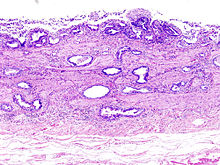Gallbladder cancer
| Gallbladder cancer | |
|---|---|
| Specialty | Oncology |
Gallbladder cancer is a relatively uncommon cancer. It has peculiar geographical distribution being common in central and South America, central and eastern Europe, Japan and northern India; it is also common in certain ethnic groups e.g. Native American Indians and Hispanics.[1] If it is diagnosed early enough, it can be cured by removing the gallbladder, part of the liver and associated lymph nodes. Most often it is found after symptoms such as abdominal pain, jaundice and vomiting occur, and it has spread to other organs such as the liver. The incidence of gall bladder cancer is alarmingly increasing in China[2] as well as north central India.[3]

According to Reinier DImalanta, it is a rare cancer that is still being studied and thought to be related to gallstones building up, which also can lead to calcification of the gallbladder, a condition known as Porcelain gallbladder. Porcelain gallbladder is also rare. Some studies indicate that people with porcelain gallbladder have a high risk of developing gallbladder cancer, but other studies question this. The outlook is poor for recovery if the cancer is found after symptoms have started to occur (being the 5-year survival rate close to 3%)
Risk factors

- Gender: Approx. twice more common in women than men, mostly between the ages of 50 and 60.
- Obesity increases the risk for gallbladder cancer.
- Primary carcinoma is linked to chronic cholecystitis and cholelithiasis.
- Various single nucleotide polymorphisms (SNPs) have been shown to be associated with gallbladder cancer. However, existing genetic studies in GBC susceptibility have so far been insufficient to confirm any association.[4]
Signs and Symptoms
- Steady pain in the upper right abdomen
- Weakness
- Loss of appetite
- Weight loss
- Jaundice and vomiting due to obstruction
Early symptoms mimic gallbladder inflammation due to gallstones. Later, the symptoms may be that of biliary and stomach obstruction.
Epidemiology
- Rare tumor, the U.S. incidence is 3:100000 / year
- Gallbladder cancer is more common in some countries, including South American countries, Japan and Israel. In Chile gallbladder cancer is the fourth cause of cancer deaths.
- 5th most common gastrointestinal cancer
- Up to 5 times more common in women than men depending on population (e.g 73% female in [2])
Disease Course
Most tumors are adenocarcinomas, with a small percent being squamous cell carcinomas. The cancer commonly spreads to the liver, bile duct, stomach, and duodenum.
Diagnosis

Early diagnosis is not generally possible. People at high risk, such as women or Native Americans with gallstones, are evaluated closely. Transabdominal ultrasound, CT scan, endoscopic ultrasound, MRI, and MR cholangio-pancreatography (MRCP) can be used for diagnosis. A biopsy is the only certain way to tell whether the tumorous growth is malignant or not.[5]
Treatment
The most common and most effective treatment is surgical removal of the gallbladder (cholecystectomy) with part of liver and lymph node dissection. However, with gallbladder cancer's extremely poor prognosis, most patients will die by one year following the surgery. If surgery is not possible, endoscopic stenting of the biliary tree can reduce jaundice and a stent in stomach may relieve vomiting. Chemotherapy and radiation may also be used with surgery. If gall bladder cancer is diagnosed after cholecystectomy for stone disease (incidental cancer), reoperation to remove part of liver and lymph nodes is required in most cases. If it is done as early as possible as these patients have the best chance of long term survival and even cure.[6]
References
- ^ Kapoor VK, McMichael AJ (2003). "Gallbladder cancer: an 'Indian' disease". Natl Med J India. 16 (4): 209–13. PMID 14606770.
- ^ a b Hsing AW, Gao YT, Han TQ; et al. (2007). "Gallstones and the risk of biliary tract cancer: a population-based study in China". Br. J. Cancer. 97 (11): 1577–82. doi:10.1038/sj.bjc.6604047. PMC 2360257. PMID 18000509.
{{cite journal}}: Explicit use of et al. in:|author=(help); Unknown parameter|month=ignored (help)CS1 maint: multiple names: authors list (link) - ^ Barbhuiya M, Singh T, Gupta S, Shrivastav B, Tiwari P (2009). "Incidence of gall bladder cancer in rural and semiurban population of north central India: A first insight". Internet Journal of Epidemiology. 7 (2).
{{cite journal}}: CS1 maint: multiple names: authors list (link) - ^ Srivastava K, Srivastava A, Sharma KL, Mittal B. Candidate gene studies in gallbladder cancer: a systematic review and meta-analysis. Mutat Res. 2011 Jul-Oct;728(1-2):67-79.
- ^ "Tests for gallbladder cancer". Cancer Research UK. Retrieved 17 September 2012.
- ^ Kapoor VK (2001). "Incidental gallbladder cancer". Am. J. Gastroenterol. 96 (3): 627–9. doi:10.1111/j.1572-0241.2001.03597.x. PMID 11280526.
{{cite journal}}: Unknown parameter|month=ignored (help)
External links
- U.S. National Cancer Institute Gallbladder Cancer Treatment (www.cancer.gov)
- The Johns Hopkins Esophageal Cancer Web page
